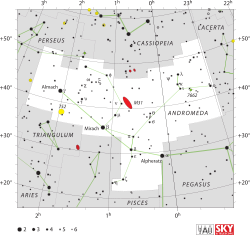
Summary
Nu Andromedae (Nu And, ν Andromedae, ν And) is a binary star in the constellation Andromeda. The system has an apparent visual magnitude of 4.5,[2] which is bright enough to be seen with the naked eye. It is approximately 620 light-years (190 parsecs) from Earth.[1] Situated just over a degree to the west of this star is the Andromeda Galaxy.[12]

| |
| Observation data Epoch J2000 Equinox J2000 | |
|---|---|
| Constellation | Andromeda |
| Right ascension | 00h 49m 48.84737s[1] |
| Declination | +41° 04′ 44.0764″[1] |
| Apparent magnitude (V) | 4.522[2] |
| Characteristics | |
| Spectral type | B4/5 V[3][4] + F8 V[5] |
| U−B color index | –0.573[2] |
| B−V color index | –0.136[2] |
| Astrometry | |
| Radial velocity (Rv) | –23.9[6] km/s |
| Proper motion (μ) | RA: +22.77 ±0.12[1] mas/yr Dec.: –18.35 ±0.09[1] mas/yr |
| Parallax (π) | 5.28 ± 0.15 mas[1] |
| Distance | 620 ± 20 ly (189 ± 5 pc) |
| Absolute magnitude (MV) | −1.85[7] |
| Orbit[5] | |
| Period (P) | 4.2827 d |
| Eccentricity (e) | 0.03 |
| Longitude of the node (Ω) | 25.° |
| Periastron epoch (T) | 18155.67 |
| Semi-amplitude (K1) (primary) | 71.7 km/s |
| Semi-amplitude (K2) (secondary) | 101.9 km/s |
| Details | |
| ν And A | |
| Mass | 5.9 ± 0.2[3] M☉ |
| Radius | 3.4[8] R☉ |
| Luminosity | 1,104[7] L☉ |
| Surface gravity (log g) | 4.12 ± 0.43[9] cgs |
| Temperature | 14,851 ± 396[9] K |
| Metallicity [Fe/H] | +0.14 ± 0.17[9] dex |
| Rotational velocity (v sin i) | 20[10] km/s |
| Age | 63.1 ± 17.9[3] Myr |
| Other designations | |
| Database references | |
| SIMBAD | data |

Nu Andromedae is spectroscopic binary[3] system with a nearly circular orbit that has a period of 4.2828 days.[5] The primary component is a B-type main sequence star with a stellar classification of B5 V.[3] The fainter secondary has a classification of F8 V,[5] which makes it an F-type main sequence star. The pair is about 63 million years old.[3]
Naming edit
In Chinese, 奎宿 (Kuí Sù), meaning Legs (asterism), refers to an asterism consisting of ν Andromedae, η Andromedae, 65 Piscium, ζ Andromedae, ε Andromedae, δ Andromedae, π Andromedae, μ Andromedae, β Andromedae, σ Piscium, τ Piscium, 91 Piscium, υ Piscium, φ Piscium, χ Piscium and ψ1 Piscium. Consequently, the Chinese name for ν Andromedae itself is 奎宿七 (Kuí Sù qī, English: the Seventh Star of Legs.)[13]
References edit
- ^ a b c d e f van Leeuwen, F. (November 2007), "Validation of the new Hipparcos reduction", Astronomy and Astrophysics, 474 (2): 653–664, arXiv:0708.1752, Bibcode:2007A&A...474..653V, doi:10.1051/0004-6361:20078357, S2CID 18759600.
- ^ a b c d Oja, T. (April 1983), "UBV photometry of FK4 and FK4 supplement stars", Astronomy and Astrophysics Supplement Series, 52: 131–134, Bibcode:1983A&AS...52..131O.
- ^ a b c d e f Tetzlaff, N.; Neuhäuser, R.; Hohle, M. M. (January 2011), "A catalogue of young runaway Hipparcos stars within 3 kpc from the Sun", Monthly Notices of the Royal Astronomical Society, 410 (1): 190–200, arXiv:1007.4883, Bibcode:2011MNRAS.410..190T, doi:10.1111/j.1365-2966.2010.17434.x, S2CID 118629873.
- ^ "Nu Andromedae, a blue main-sequence star in Andromeda". astrostudio.org. Archived from the original on 23 September 2015. Retrieved 18 August 2014.
- ^ a b c d Pourbaix, D.; et al. (September 2004), "SB9: The ninth catalogue of spectroscopic binary orbits", Astronomy and Astrophysics, 424: 727–732, arXiv:astro-ph/0406573, Bibcode:2004A&A...424..727P, doi:10.1051/0004-6361:20041213, S2CID 119387088.
- ^ Wilson, R. E. (1953), "General Catalogue of Stellar Radial Velocities", Carnegie Institute Washington D.C. Publication, Carnegie Institute of Washington D.C., Bibcode:1953GCRV..C......0W.
- ^ a b Anderson, E.; Francis, Ch. (2012), "XHIP: An extended hipparcos compilation", Astronomy Letters, 38 (5): 331, arXiv:1108.4971, Bibcode:2012AstL...38..331A, doi:10.1134/S1063773712050015, S2CID 119257644.
- ^ Pasinetti Fracassini, L. E.; et al. (February 2001), "Catalogue of Apparent Diameters and Absolute Radii of Stars (CADARS) - Third edition - Comments and statistics", Astronomy and Astrophysics, 367 (2): 521–524, arXiv:astro-ph/0012289, Bibcode:2001A&A...367..521P, doi:10.1051/0004-6361:20000451, S2CID 425754.
- ^ a b c Koleva, M.; Vazdekis, A. (February 2012), "Stellar population models in the UV. I. Characterisation of the New Generation Stellar Library", Astronomy & Astrophysics, 538: A143, arXiv:1111.5449, Bibcode:2012A&A...538A.143K, doi:10.1051/0004-6361/201118065, S2CID 53999614.
- ^ Abt, Helmut A.; Levato, Hugo; Grosso, Monica (July 2002), "Rotational Velocities of B Stars", The Astrophysical Journal, 573 (1): 359–365, Bibcode:2002ApJ...573..359A, doi:10.1086/340590.
- ^ "35 And -- Star", SIMBAD Astronomical Object Database, Centre de Données astronomiques de Strasbourg, retrieved 2012-06-22.
- ^ Mollise, Rod (2006), The Urban Astronomer's Guide: A Walking Tour of the Cosmos for City Sky Watchers, Patrick Moore's Practical Astronomy Series, Springer, p. 178, ISBN 1846282160.
- ^ (in Chinese) AEEA (Activities of Exhibition and Education in Astronomy) 天文教育資訊網 2006 年 5 月 19 日
External links edit
- SIMBAD (ed.). "35 And -- Spectroscopic binary". Retrieved 11 September 2010.
- Kaler, James B. "Nu And". Stars. Retrieved 11 September 2010.


